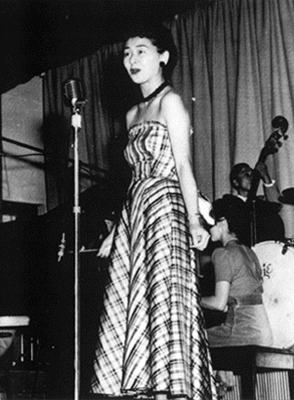|
Mary Kageyama Nomura "The Songbird of Manzanar" |
 |
|
One of the most romantic love stories of the Internment took place at the Manzanar Internment Camp, high in the Sierra Nevada Mountains of California. It is a story about the magic of music, centering around Mary Kageyama Nomura, the "Songbird of Manzanar." Mary's Early LifeMary Kageyama learned Japanese and American singing and dance from her mother at an early age, having her first public performance at age 4. After the tragic death of her mother when she was only 8, Mary's older brother Frank and older sister Fumi, themselves only 17 and 16 at the time, dropped out of school to support Mary and her two younger sisters. Mary was able to continue her music studies in school. At Venice High School in Los Angeles Mary sang in the choir and performed in talent shows. In August 1941, at the annual Nisei Week Festival, a celebration of Japanese culture held at Yamato Hall in Los Angeles, Mary won first prize. InternmentIn 1942, the US Military, surpressing its own evidence to the contrary and ignoring due process, falsely claimed there was a "military necessity" to intern all 120,000 men, women and children of Japanese descent living on the West Coast of the U.S.A. Two-thirds of the internees were, like Mary, native-born American citizens under the age of 21. Mary was interned in Manzanar Internment Camp in eastern California. During the years of the Internment, music provided a rare solace for the internees, distracting them from the bleak reality of their desert prisons. Mary was a member of a girl's social club called the Modernaires and sang at dances sponsored by the club. She soon became known throughout the camp as the "Songbird of Manzanar." Love SongsAt one of the dances, a young man named Shi Nomura heard her sing - and realized it was her voice that had captivated him in August 1941 at Yamato Hall as she sang "Liebestraum" - "A Dream of Love." He courted her and won her heart, and as the war came to a close they were engaged to be married. Mary was able to leave Manzanar in February 1945, slightly before Shi. While they were apart, Shi wrote love poems and sent them to Mary in Los Angeles. Mary set two of the poems to music, sang them for a recording - and mailed the records back to Shi in Manzanar. Mary and Shi married in June 1945 and settled in Los Angeles. PresentMary's original recordings are preserved in the Manzanar Room of the Eastern California Museum, in the town of Independance, 14 miles north of Manzanar. In the collection, which Shi started in the museum in the 1970s to preserve the history of the camp, are two other recordings that Mary actually made at Manzanar while still an internee. The Eastern California Museum and Mary Kageyama Nomura have graciously given permission to use both songs, "Can't Fool This Heart Of Mine" and "Don't Ever Change," together with photographs of Mary and her family, in the virtual reality installation Beyond Manzanar. Mary Nomura continues to sing, and has passed her gift on to her children and grandchildren. Contemporary performances of Mary's are included in the album "Music to Remember" and the documentary video "Words, Weavings and Songs" interviews her about her life and her art. Both are available at the Japanese American National Museum in Los Angeles, California. The information on this page came partly from personal conversations that Tamiko Thiel held with Mary Nomura and partly from a fascinating book that focuses on Shi's life to give a very personal experience of the Internment: "I am an American" by Jerry Stanley. Photo courtesy of Mary Kageyama Nomura. |